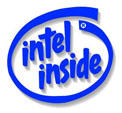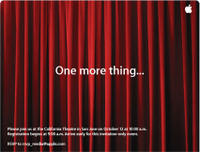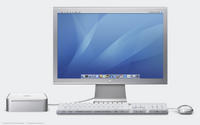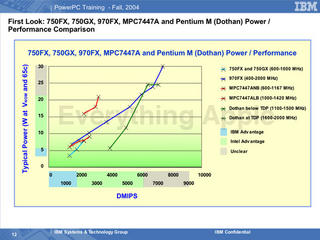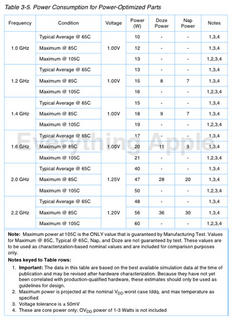In my previous
iTunes 6 article I lamented the fact that Apple has chosen to limit video downloads to files with a resolution of
320x240 (or smaller), and expressed hope that Apple would release
720x480 (480p) standard definition video in the future through iTunes.
Unfortunately, Apple's video format of choice,
H.264, is extremely hard to decode. The new iPod is likely hardware limited to speeds sufficient only to decode H.264 files up to 320x240 at 30 frames per second. Thus, Apple has a hard cap on the video resolution and bitrate. I also mentioned in the article that while 320x240 was watchable on a computer, it is of fairly low quality. Similarly, that output would look mediocre to poor, played from an iPod on a medium-sized or larger TV. Now, before you bring this up, I am well aware of the similar arguments made when it was announced that Apple had chosen 128 Kbps AAC for audio for iTunes. I have always felt that 128 Kbps AAC, although not perfect, was adequate for this purpose. Video is a very different situation however, and I feel that 320x240 is subjectively much lower quality for video playback than 128 Kbps AAC is for audio playback.
To rectify this issue, Apple would need to release a new iPod that supported decoding of higher resolution video. That video could played at native resolution from the iPod's video output to a TV for optimium quality, but could be resized on-the-fly for the iPod's small screen. Apple could choose one of several options:
1) Orphan the current iPod in the future, and only release higher resolution video for newer iPods and computer playback.
2) Start releasing multiple versions of the same video at the iTunes video store, with smaller ones for the 5G iPods, and larger ones for 6G iPods and beyond.
3) Provide software for the consumer to transcode higher bitrate video files to lower bitrates video files for the 5G iPod.
4) Stick with 320x240.
Option #4 could happen, but I just hope not. Option #3 seems unnecessarily complex, and would be very slow too. It's easier just to have the video pre-recorded and ready for download. This brings us to Option #2. This could be doable especially for a short time, during a transition period, but it also seems unnecessarily complex for the average consumer. A variation on Option #2 would be to have iPods remain at 320x240, but have larger videos for computer set top boxes or future Mac mini-like home theatre machines, but that also seems like a fairly cumbersome solution. We're left with Option #1, which would be dependent solely on having new iPod hardware, capable of fast enough decoding to make it work.
It appears that implementing Option #1 would be a ways off yet, since there may be no available chips that are currently both fast enough for higher datarate H.264 decoding, while remaining low power enough to be useful in an iPod. Also, the higher the resolution, the harder the decode, and the longer it would take before such an iPod could be released.
With this and other issues in mind, it seems I may have been too quick to push for 480p material. After looking at the potential internet bandwidth requirements, I think 480p may be probitive, due to cost, storage requirements, and download times. Bandwidth is increasing but the reality for the near and mid-term is that bandwidth will continue to be an issue. Reasonable quality 480p H.264 might take as much as 20 MB per minute of video, and at today's home broadband speeds in North America, that could mean 30-60 minutes of download time for a single TV episode and that's clearly not ideal.
Fortunately,
480x360 video and
480x270 widescreen video actually looks reasonably good on medium-sized screens, if encoded at high enough bitrates. Such video is in the ballpark range of about 8 MB per minute, and full length 1 hour TV episodes would be somewhere in the range of about 350 MB each. (A TV hour is only about 44 minutes. Yes there are that many commercials.) This essentially halves download time compared to 480p, yet still maintains reasonably quality, at a level that is noticeably better than 320x240 (or 320x180) even to the eyes of average customers. Interestingly, the PSP, which Sony is marketing partially as a portable movie device, has a widescreen resolution of 480x272. Obviously Sony feels that the 480xXXX screen size is a good one. Apple wouldn't have to use the same size screen, but could create an iPod that can downsample 480x360 H.264 to the current 320x240 screen size, to maintain the iPod's nice form factor yet give it support for better quality video for TV display. Such files would also look good played back from iTunes directly on the computer's screen. Ironically, before iTunes 6 launched, Apple itself encoded and distributed music videos at 480x360, so it seems that Apple too felt the 480xXXX resolution was the sweet spot. Unfortunately, hardware limitations have Apple's hands tied... for now. (Ironically, the iPod is already able to play back up to 480x480 MPEG4, but Apple seems to have made up its mind not to use MPEG4 for this. The present and the future for Apple is H.264.) Still, I would be overjoyed if Apple could somehow implement a system with 640x480 "fullscreen" and 640x360 (or even 720x480) widescreen standard definition video. 480x360 is a good compromise appropriate for next year, but a maximum 640x480 resolution would be almost ideal from an image quality point of view, other issues notwithstanding. As for high definition, let's not even go there.
How all this pans out in the next year or two will be very interesting. This week's iTunes 6 launch isn't yet the revolution for video, but several of the pieces are now in place, and the revolution may just start soon, with better quality video, better video selection, and a simple download concept to provide reasonable quality video for our computers, for our iPods, and for our TVs. And indeed there is hope. Steve Jobs didn't push this iPod as a video iPod. He pushed it as an iPod which also happens to play video. Perhaps 2006 will see the appearance of a "real" iPod video.
[Update 2005-10-15]The first comment in response to my article is an interesting one:
Jobs doesn't feel the portable video device has much usefullness or market demand. The new iPod is more of a trojan horse to establish momentum and move the content providers to get into the action. Apple's working with Intel on future technologies so we may see better video quality in future hand helds; but the bigger market is home consumption. "Front Row" is only the first small step. The delivery and processing of HD video is the ultimate target. As Intel moves into the TV chip business we may well see Apple move with them.
I will respond by saying that there are couple of fundamental issues which make video downloads problematic:
1) 99.9% of TVs do not have any sort of computer connected to them
2) Apple's video download service offers no way of burning the content to video DVD.
Most people, like me, hate watching movies and TV shows on their computers. and require the use of a TV for this purpose. Apple has a few options to solve this problem.
1) Create a new set top box that can access content on the iTunes Store. Basically it would be a set top box with recording capabilities for video on demand. However, this is remarkably similar to the boxes already provided by the cable companies.
2) Sell a Mac mini-type computer for use with the TV. The computer could function as sort of a set top box as above, or stream video from a 2nd computer on which the videos are hosted. This would work but would require some sort of network connection. Wireless would be doable, but it would depend upon the size the house, the strength of the wireless signal, and having multiple computers.
3) Sell an iPod which can output higher resolution video.
Options #1 and #2 are in many ways very similar in concept, and just differ in implementation. Option #3 is quite a different beast, but has a lot of potential to move a lot of iPods. If I knew I could buy missed TV show episodes for $2 to play on my TV (which has no computer hooked up to it), I'd be buying quite a few of them, and I would buy a new iPod too, to act as the very convenient and portable source.
However, this requires good video output from the iPod, and 320x240 does not qualify as good, at any bitrate.
There is also another option, a revamped Airport Express that also does video. This seems like the logical progression of Airport, but Apple may wait until 802.11n is available before moving on and selling this. However, when they do release an Airport Video Express, a single file size for video downloads (that worked on the Airport Video Express, computer screens, and the iPod) would still be preferred, since it would mean less confusion for consumers.
[Update 2005-10-16]I have been told that most digital broadcast video is 352x480 (60 fps interlaced). That's just 2% less pixels displayed per second compared to the 480x360 (30 fps progressive scan) I was advocating, so it sounds like the digital broadcasters think that is the sweet spot too. (FYI: I'm not a video guru, nor do I play one on iTunes TV, but apparently 352 is used because it is a multiple of 16, the size of a single 4x4
macroblock.)
Oh and just one more thing... Ironically, Apple's free H.264 stream of the
"One more thing..." keynote is 640x360, three times the resolution of Apple's $1.99 videos on iTunes. :)





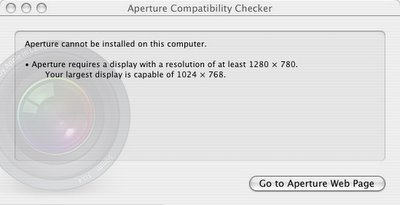



 According to the Apple Store front page, Aperture is now shipping. However, when you attempt to purchase it, it says it's shipping in one week. Furthermore, Amazon has a November 30 release date, and there have not yet been any reports of end users receiving their copies.
According to the Apple Store front page, Aperture is now shipping. However, when you attempt to purchase it, it says it's shipping in one week. Furthermore, Amazon has a November 30 release date, and there have not yet been any reports of end users receiving their copies.









